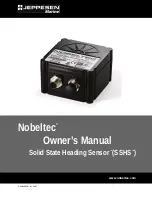
CALIBRATION
Jeppesen Marine
9
CALIBRATION
Warning: It is imperative that calibration procedures be carried out upon installation
of the SSHS to ensure accurate readings.
In order to provide accurate heading indication, the SSHS must be calibrated after installation.
The two calibration procedures are
Magnetic Deviation Calibration
(see below) and
Installation-Offset Correction
(see
Page 13
)
.
Calibration should be carried out immediately after initial compass installation, and again
any
time that the magnetic environment of the vessel has changed significantly
(for example, if
new cables have been routed near the compass or new equipment made of ferrous metal has
been installed near the compass).
Methods of Calibrating for Magnetic Deviation
Magnetic and / or ferrous items near your SSHS magnetic compass can cause errors in the
compass’ heading output. These errors are referred to as magnetic deviation.
The SSHS compass can compensate for heading errors caused by magnetic deviation by
learning about the magnetic environment in which it has been mounted.
Magnetic Deviation Calibration is done using one of three possible procedures:
• Method 1. Automatically at Power-Up (see
Page 14
)
• Method 2. Through the NMEA 0183 Interface (see
Appendix A
)
• Method 3. Through the NMEA 2000 Interface (see
Appendix B
)*
Method #1 is automatic when power is removed and re-supplied during compass use.
Methods 2 & 3 allow users with direct access to NMEA 0183 and / or NMEA 2000 interfaces to
perform magnetic deviation calibration directly through those interfaces (see
Appendices A
and
B
). These direct-access methods provide an indication of success or failure and the
causes of failure, when applicable.
Note:
Jeppesen Marine does not provide technical support for the NMEA 2000
interface as of this printing.
Each of these three methods require that the vessel be turned in successive circles, during
which time the SSHS uses the changing heading information and readings from the angular
rate sensor to calculate hard and soft iron magnetic deviation(s).
Upon a successful completion of deviation calibration, the SSHS stores the deviation values in
permanent memory for subsequent compensation. Under certain conditions (i.e., turning too
quickly or too slowly), the SSHS may not successfully complete the calibration process, and
will be unable to store the deviation values. Therefore, it is important to always verify that the
deviation calibration process completed successfully.
Содержание Nobeltec Solid State Heading Sensor
Страница 1: ...www nobeltec com Nobeltec Owner s Manual Solid State Heading Sensor SSHS RAHSU00001 rev 03 07...
Страница 2: ......
Страница 4: ...Solid State Heading Sensor SSHS Owner s Manual ii...
Страница 6: ...Solid State Heading Sensor SSHS Owner s Manual ii...
Страница 28: ...Solid State Heading Sensor SSHS Owner s Manual 22...
Страница 47: ...APPENDIX B NMEA 2000 INTERFACING Jeppesen Marine 41...
















































